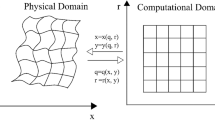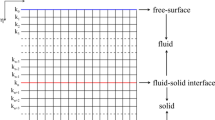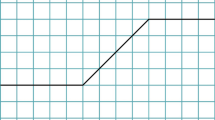Abstract
In order to model the seismic wave field with surface topography, we present a method of transforming curved grids into rectangular grids in two different coordinate systems. Then the 3D wave equation in the transformed coordinate system is derived. The wave field is modeled using the finite-difference method in the transformed coordinate system. The model calculation shows that this method is able to model the seismic wave field with fluctuating surface topography and achieve good results. Finally, the energy curves of the direct and reflected waves are analyzed to show that surface topography has a great influence on the seismic wave’s dynamic properties.
Similar content being viewed by others
References
Hestholm, S., 2003, Elastic wave modeling with free surfaces: stability of long simulations: Geophysics, 68(1), 314–321.
Hestholm, S., and Ruud, B., 1998, 3-D finite-difference elastic wave modeling including surface topography: Geophysics, 63(2), 613–622.
Liu, Y., Li C. C., and Mou, Y. G., 1998, Finite-difference numerical modeling of any even-order accuracy: Oil Geophysical Prospecting (in Chinese), 31(1), 1–10.
Nielsen, P., Flemming, If., Berg, P., and Skovgaard, O., 1994, Using the pseudospectral technique on curved grids for 2D acoustic forward modeling: Geophysical Prospecting, 42(3), 321–341.
Tessmer, E., and Kosloff, D., 1994, 3-D elastic modeling with surface topography by a Chebychev spectral method: Geophysics, 59(3), 464–473.
Wang, R. Q., 2003, Forward seismic wave modeling with any differential precision integral method: Oil Geophysical Prospecting (in Chinese), 38(3), 252–257.
Wang, Y. X., Zhang G. Q., and Zhou R. F., 2002, An absorbing layer method of 3-D seismic migration in an irregular acquisition geometry: Chinese J. Geophys., (in Chinese) 45(5), 702–706.
Zhu, S. W., 2005, Differential forward modeling of wave equation having regular grid and any order precision: Oil Geophysical Prospecting (in Chinese), 40(2), 149–153.
Author information
Authors and Affiliations
Additional information
This research is sponsored by the Scientific Research Project of the China Geological Survey “Basic Theory, Special Collection and Special Process Method Research on Metal Mineral Seismic Exploration” (Project Number: 2000201 0002146).
Wang Xiangchun is now studying for his PhD in the School of Geophysics and Information Technology, China University of Geosciences (Beijing), His research interest is the modeling and continuation of seismic wavefields with relief topography.
Rights and permissions
About this article
Cite this article
Wang, X., Liu, X. 3-D acoustic wave equation forward modeling with topography. Appl. Geophys. 4, 8–15 (2007). https://doi.org/10.1007/s11770-007-0002-2
Received:
Revised:
Issue Date:
DOI: https://doi.org/10.1007/s11770-007-0002-2




